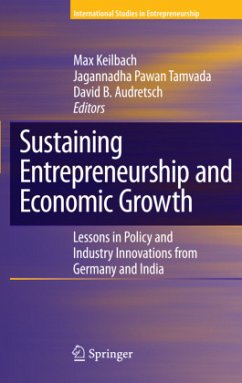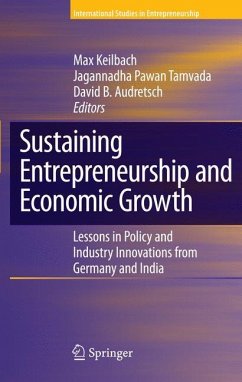
Innovation Policies, Business Creation and Economic Development
A Comparative Approach
Herausgegeben: Aydogan, Neslihan
Versandkostenfrei!
Versandfertig in 6-10 Tagen
113,99 €
inkl. MwSt.

PAYBACK Punkte
57 °P sammeln!
This volume explores the dynamics of the innovation process in developing countries with respect to economic growth. First, the book focuses on the relationship between innovation and economic development from a macroeconomic perspective, with an emphasis on incorporating technological change and intellectual property rights into the theoretical model. This section also considers that the meaning of such fundamental terms as "innovation", "entrepreneurship", and "macroeconomic policies", vary considerably across nations and cultures, with profound implications for the development of policies designed to promote new business creation, growth, and competitiveness. The second section of the book focuses on a microeconomic approach, taking a sociological approach to the economics of creativity at the organizational level. Topics include the effect of beliefs on organizational creativity and the relationship between leadership style and the value system of the entrepreneur on firm-level innovation. The third part of the book focuses on small and medium-sized enterprises, providing empirical research from Turkey, India, and the European Union to shed light on product, process, organizational and marketing innovations, with respect to economic development. The volume concludes with discussion of the impact of well-functioning national innovation systems on decreasing the gaps between the developed and developing nations.
It is now apparent to many scholars and practitioners that research and development activities and innovation are the pathways to sustainable economic growth. One also recognizes that delving into a topic as such is rather challenging as it is a multidimensional task. We have learned quite a bit on the innovation-growth relationship of the dev- oped countries based on the extensive research on the topic. However, we are yet to understand the very same process for the developing countries where the challenges are expected to be paramount. There obviously is few empirical and theoretical discussion on this topic. This book dares to provide a succinct discussion on a wide array of issues on the innovation and growth relationship for the developing countries. The book starts off by providing the reader with a promising - ternative to endogenous growth models that entails understanding the effect of variables, such as technological change on growth in cons- erable detail. The next step in the book involves a thorough analysis of economic growth models and how the investment climate affects innovationand entrepreneurship and hence economic growth. Against this background is examined the context of the telecommunications industry in Turkey. Following this, we delve into understanding the radical versusincremental innovationactivities,where itis argued that developing nations are more likely to engage in radical innovation, whereas developing nations are engaged in incremental innovation.














